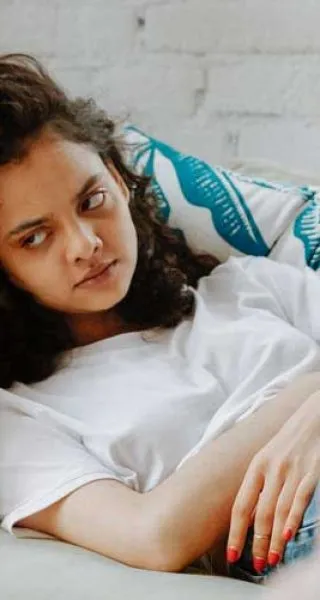Some people may find the changing of leaves in fall and the crispy cold of winter comforting, but others have difficulty waking up, feel tired all day or eat a lot more. They may find that this time of year affects their mental health negatively, or that they are feeling depressed.
If the winter blues come around and you find yourself struggling with depressive symptoms every year, you may be suffering from seasonal depression.
Understanding Seasonal Depression

Seasonal depression is experiencing major depression seasonally. It involves a mood and behavior shift for at least two consecutive years along with the calendar. It is not a separate mood disorder, but instead a type of major depression that usually starts in young adulthood, and is more common in women than in men.
Seasonal Affective Disorder (SAD)
Seasonal depression is also referred to as Seasonal Affective Disorder (SAD). Since its symptoms usually appear more commonly and severely in the winter and resolve during the spring and summer months, it is sometimes known as 'winter depression'. The onset of SAD usually begins in the late fall and early winter, when the days are shorter are temperatures drop.
While the milder form is colloquially called 'winter blues', seasonal affective disorder is a subtype of depression or bipolar disorder typically occurring when the seasons change, usually in the winter months. Some people experience SAD in late spring or early summer, as a rare form of SAD known as 'summer depression'.
As seasonal affective disorder may mimic other conditions, like an underactive thyroid, low blood sugar, viral illnesses, chronic fatigue, or mood disorders, it may take a while to diagnose. It could also co-occur with substance abuse or anxiety. For these reasons, seeing a healthcare provider for a diagnosis and receiving treatment as early as possible is key.
Symptoms of Seasonal Affective Disorder (SAD)
The signs and symptoms of SAD include those associated with major depression, but they appear in a recurrent seasonal pattern. Symptoms of seasonal affective disorder return each year for almost 70% of people living with the condition. SAD begins and ends at about the same times yearly, and depressive episodes will last four to five months per year. Some symptoms differ between winter and summer SAD.
SAD symptoms include a persistent low mood or feeling sad, feelings of despair, guilt or worthlessness, a loss of pleasure or interest in activities, and irritability. Other warning signs that also occur in other forms of depression include trouble concentrating, having less energy, more desire to be alone, and suicidal thoughts or behavior.
Symptoms of Seasonal affective disorder that are specific to winter SAD and may have onset in the late fall include:
- Extreme changes of mood - in some people, periods of mania in the summer months
- Oversleeping
- Craving starchy and sweet foods -carbohydrate cravings- which leads to weight gain
- Loss of libido and decreased interest in physical contact
- Tiredness and low energy
- Desire to avoid social contact
SAD symptoms specific to the opposite season begin late spring to early summer, and include:
- Trouble sleeping (insomnia)
- Poor appetite and weight gain
- Agitation
- Anxiety
- Episodes of violent behavior
Causes of Seasonal Depression
Less sunlight or less daylight has been thought to be linked to a chemical change in the brain that could play a role in seasonal affective disorder. Those living far away from the equator, such as farther north where daylight hours are shorter in the winter, are thought to be more likely to develop SAD.
Sunlight helps to produce Vitamin D, from which serotonin activity gets a boost. The level of this brain chemical - that affects mood- is affected by a vitamin D deficiency, which often happens due to less sun in the winter. Lower levels of serotonin have been linked to depression; brain scans have shown that people with seasonal depression in the winter had higher levels of a serotonin protein, which removes serotonin.
Even though Vitamin D supplements may seem like a possible solution, there is no convincing evidence that they are therapeutic for seasonal affective disorder.
A hormone called melatonin has also been linked to Seasonal affective disorder (SAD). As a sleep-related hormone, melatonin can affect sleep patterns and mood. It is produced at increased levels in the dark, so when days are shorter and darker, melatonin production increases. The hormone can also affect a person's circadian rhythm, otherwise known as the 'biological clock', causing internal sleeping patterns to be out of sync with 'external clocks'.
The Diagnostic and Statistical Manual ofMental Disordersdefines seasonal affective disorder as a type of major depressive disorder (MDD). This makes SAD more likely in people who suffer from MDD.
Those who have bipolar disorder are also at increased risk of SAD. Bipolar II disorder, which is less severe than typical bipolar I disorder, is associated with recurrent hypomanic and depressive episodes. As an example, spring and summer may bring about symptoms of mania, anxiety, agitation, and irritability, while depression may be experienced during winter or fall months.
Treatments for Seasonal Affective Disorder (SAD)

With seasons coming and going every year, how is SAD treated?
The treatments for winter onset SAD and summer onset SAD differ and may include or combine preventative treatment, medication, or different types of therapies.
Preventative Treatment
Preventative treatment only refers to taking early steps to manage symptoms, as there is no way to prevent the development of seasonal affective disorder. Since seasonal depression reoccurs in a predictable pattern, taking these early steps may reduce symptoms or prevent depressive episodes from getting worse over time.
Steps include exercising more, spending more time outside, visiting climates that have more sun, increasing the amount of light at home, and practicing stress management techniques such as meditation. A person can also ask healthcare providers if they want to initiate other forms of treatment early, such as taking medications. Some people may begin light therapy earlier in the fall before the onset of SAD, to prevent symptoms.
Talk Therapy
Therapy from a mental health professional, such as cognitive behavioral therapy (CBT) is a type of individual talk therapy that can help people to learn how to cope with difficult situations healthily. CBT has been adapted for people with Seasonal affective disorder, by focusing on replacing negative thoughts related to the winter season, and can also be conducted in weekly group sessions.
Medications
Because SAD, similar to other types of depression, is associated with serotonin activity disturbances, antidepressant medications such as selective serotonin reuptake inhibitors (SSRIs) are used to treat SAD. One kind of antidepressant, bupropion, has been approved by the U.S. Food and Drug Administration (FDA) to prevent the recurrence of seasonal depressive episodes. In extended-release form, it helps when taken daily from fall until the next early spring.
Light Therapy
As light seems to play a big role in seasonal affective disorder, phototherapy or bright light therapy has been evaluated for its ability to suppress the secretion of melatonin. Even though this therapy has not been linked to an antidepressant effect, light therapy has been shown effective in improving SAD symptoms.
Light therapy is the best investigated and most successful intervention that is a home-based treatment. A special lamp in a box emits a bright light which is used to stimulate exposure to sunlight. Natural outdoor light that occurs shortly after sunrise, or 'full-spectrum' light has an antidepressant effect; the bright light from the lightbox is therefore around twenty times brighter than normal room lighting. A person undergoes light therapy by sitting about two feet away from the light box for about ten to fifteen minutes per day. The times may increase to half an hour or more depending on the person's response.
Some people recover within days of receiving light therapy, and most see improvements within one or two weeks of beginning treatment. SAD symptoms may not go away so soon for others, and a doctor may increase the light therapy sessions to more times a day. Those who do respond to light therapy are usually encouraged to continue its use until springtime when they can be exposed to sunlight again.
The side effects of using the light boxes are minimal as they filter out potentially damaging UV light, making it a safe therapy for most. But caution should be taken for those with sensitive skin or bipolar disorder.
Transcranial Magnetic Stimulation (TMS)
TMS is a non-invasive, painless, and drug-free method of treating depression through brain stimulation therapy. It uses electromagnetic pulses to stimulate nerve cells that are underactive, magnetic fields are produced by electrical current that flows through a coil. These magnetic fields pass into the skull as brief, repetitive magnetic pulses and produce a field of electricity underneath it. The currents stimulate and excite brain cells or neurons that are underactive, causing them to release more chemical messengers or neurotransmitters. The result is altered connectivity and communication between neurons.
An ability to 'reset' pathways and communication allows transcranial magnetic stimulation to treat major depression and other mood disorders. TMS is especially helpful for those suffering from SAD as a treatment schedule typically involves five sessions a week over six weeks, and is followed by two to three weeks of tapering off.
Where Can I Find a Treatment Center for Seasonal Affective Disorder?

If the winter months get you down more than you think they should, GIA Miami is here to help.
We recognize that depression affects everybody differently, which is why an in-depth admissions process and individualized treatment plans ensure that you will receive the most effective treatment.
With cutting-edge technologies and compassionate medical professionals with years of experience in mental health, our evidence-based treatment approaches are tailored to suit your needs. GIA Miami can help treat your depression by providing cognitive-behavioral therapy (CBT), transcranial magnetic stimulation (TMS), group therapy, family therapy, psychiatric services, and functional medicine.

